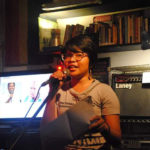Flotsam
Once upon a time, because now is a time when history has been obliterated, because history is written in the bones and beasts of the land and both have been now mutilated and mutated beyond recognition, they made houses out of meat.
At least that is what the Mamanlaut call them, those cities the savants have named Balay Hunyango, because the houses smell faintly of offal, or like some dead animal left out in the open for too long, or because that’s what they looked like, but also because they have no time or need for more elegant names. When the godstorms come and bring the sangsangin-the smell of the fetid water, fishkill, and carbonsour fumes-the houses “piss”: their pores expel the transmuted waste of Balay Hunyango, a substance so concentrated that the odors the typhoon winds had blown their way couldn’t completely overpower the smell it exuded. On calm days the meat-houses do this, too, in smaller increments, as vapor. The Mamanlaut have grown used to it.
They had a sheen to them, wet and slick with dark rainbows as if slathered with oil, that during the long greenhouse summers became almost limestone-white at high noon to reflect heat away. They were shaped like giant tortoises, if the body and the shell were one thing: “legs” holding up a body that appeared something like a cross between a conch shell and a brain. If you watched them closely without blinking, they would look stationary, like meganimbus clouds that always seemed to be so far away and never any nearer, but look away and back again for a few moments and you would notice them shift slightly, as if they had moved or morphed, which they do.
They adjust to external stimuli. Usually they move like this, imperceptible, except on really bad days when the surges or godstorms would get too strong and they would have to “walk” to more stable ground. In the lowlands, of course, this meant walking through the rubble and rusted remains of old cities, cities built by the savants’ precursors, back when they didn’t know yet the metamorphic art of transubstantiation.
§
We are making it better, they would say. We have learned. We are not wasteful, and our houses aren’t cold and hard and stiff things.
Balay Hunyango was built through a process called transubstantiation. The savants have perfected the study of living things, the nonliving things, and the things that lived between the spaces of each, that occupy the spaces matter cannot occupy. They distilled from what they called the heathen songs and crude sciences, made necessary improvements. They say they had learned how to do so from their predecessors long ago, who found the bridge between the physical and the psychical, found that such a metaphysics was possible through painstaking research into the interactions of aether with matter and energy. And they needed to.
The world before, with its gargantuan metropolitan appetites, had collapsed; the steel bones and concrete shells of their glass cities had grown brittle, pounded by godstorms and poisoned by neglect. The bittersalt seas have risen, gone further inland, eating up the edges of the islands. Half the year was feverhot, with occasional acid rains, and the other half was ruled by godstorm. There was no high tide or low tide, just days when the eternal surge does or does not come. Farther inland where there used to be freshwater, fetid rivers choked on mutant kangkong, lily, and carpet upon carpet of duckweed and scum; in some of the bigger rivers and lakes, the green monstrosities had formed communities, deep poison-green leaves and limbs intertwining thickly, finding a new language to speak to each other through their exhalations; sometimes you could smell the psychemicals they hiss into the air. The greenmess was so thick in places even an adult Mamanlaut could walk on them, pick off snails that ate and bred on them and other animals that got tangled in the trap. These, too, they try to eat, alongside the green.
This was the best they could do, to save the hardiest, the strongest, the ones that multiplied the fastest. Cut the many losses and move forward. They introduced the mutant vegetables and weeds into the rivers so the Mamanlaut could have something to eat or build their rafts with, or to use for improvised filtration, they said. They made it so that they were edible but resilient, perfect for the Mamanlaut, no? they would add, secure in their goodwill.
Mamanlaut didn’t live in meat-houses. Even then they were told they were too many already, that sheltering an overpopulated community would make this tender ecosystem collapse inside them. But they let the Mamanlaut lash their palayagan to the legs of meat-houses, or built readymade shelters made from the leavings of collapsed cities when the monsoon brings the storms. There are those who were taken in and decontaminated to do important work; after all, to maintain the meat-houses was to maintain everyone’s survival.
§
The savants called it Balay Hunyango because that’s what they needed, a city that could change and defend itself, an organism capable of adaptation to whatever freak condition had become their daily nightmare.
Walls of membrane that could breathe, help circulate and recycle air and secrete the byproducts of their daily processes. When earthquakes and strong winds come battering Balay Hunyango, the meat-houses fortified themselves, the membranes going stiff yet pliable enough so they wouldn’t shatter and crumble when the earth rattled them.
Many whispered that it was the savants’ forefathers that had left the earth this way, that they had abandoned the world when they had discovered that liminal space beyond gravity, light, and time, where reality itself was mutable, up there, in the stars, in the swirling blackness at the center of galaxies. With one big leap, one valiant push, those who had the art of surviving the journey rocketed into the sky, or vanished between planes of existence. It sounded simple. All it took was massive energy. They had eaten through most of the earth, anyway, and it was a simple matter of pooling as much fuel as they could together, all the best minds.
During this great enterprise, they created aether.
See, aether was soul-stuff congealed and crystallized, both fuel and by-product of transubstantiation. Back at that seeming mythic time when the savants’ forebears, and those who could afford to join them, made the Big Leap to escape the earth. There was a bright light, a quaking in the very atoms of the world, and they were gone, save for some of the most learned of them who had, for some reason, stayed behind. The earth was enveloped in pyroclastic and zodiacal cloud, and many more who had not died in the process of the Big Leap had perished under that cloud as it blocked out the sun. Only when the early savants had seen what new mineral now hung in the air and rained down on the world, what this new material did upon contact with souls that remained alive, bent over in desperate prayer, how it reacted to the touch of a living thing, did they realize what it was they could harness. Mana. Boon. A renewable resource.
The details of this are murky. Even the savants themselves don’t remember everything, or so they say. But they did hang onto an idea, would repeat it to themselves often and to others twice as much because they didn’t know any other way to live—that they had been left behind for a purpose, that they were here to return true equilibrium to the earth, that they had chosen to stay.
§
A few would whisper that they had stolen the art from the ancestors of the Mamanlaut—the art of the commune, the shaman’s trances, the psychic conversations. But nobody really knows for sure anymore, because the Mamanlaut, too, have lost that language.
It would not be the first thing that had been taken from them. Once, long ago before the rapid decay and the Big Leap had flattened all diversity on the planet, the people who lived in these islands confused the word for “saving” with “unmaking”, and the word hung over the bodies they left in fields of kangkong. The plants do not understand the alien language of human tongues, or the alien language of human violence, or the terms of their forced complicity. Silent, the kangkong enveloped the rotting flesh, and in the dark of no names they would feed. Fishes, leeches, insects, monitor lizards, parasites. The bones joined the silt below, over time calcifying, turning to sand or stone.
The men and women who lost their names to the dark and lost their bodies to the riverbed had tried to claim their land back, many many years ago, when all the great men had thought to mine from them was metal. The savants mine still, this time for aether-veins.
Nameless, the longdead are everywhere. There is so much of them in the soil, in the water, in the blood and bellies of the Mamanlaut. The trees have absorbed them into their armored trunks. So much meat. Even the Mamanlaut have lost their old names, names that told of their ties to the land—the first-by-the-river, the men-of-the-forest, they who were foremost to swim upriver, they who were first among the underbrush—but in their dreams and their daily pains somewhere in their skin retain the water their bodies once held. It seems fitting, somehow, to have lost their land first, and now everyone else has lost their land, too. Now, everyone who is not a savant is a Mamanlaut because when the sea had swallowed up most of the low-lying land, fishing was all the livelihood they could find here: outside the walls, you fished for whatever scraps they give, or the scraps thrown up by the ocean, or sate yourself on bony tilapia, snakehead, and other such pests, another gift from the savants’ efforts to preserve them. If you were lucky to live within the pseudomembrane walls of Balay Hunyango, you were put to work. The worst kind of fishing was diving for aether-veins.
Transubstantiation requires only small amounts at a time, they would say. It is the most efficient kind of substance, at once fuel, at once conductor, where metamorphosis takes place. And whatever waste the use of aether creates only creates more aether, as it dissipates into the atmosphere, to be consumed by living things, and to sink down into the earth and water, forming veins in the dark.
They reminded the Mamanlaut how important it was to keep the aether coming. That it was all their duty to keep the world turning. To salvage.
The Mamanlaut were singing the song of god the night it washed ashore. It had been a terrible drought, and they were living on the insectpests that clung to the legs of the meat-houses. Their voices floated over the waves. In the dark, the gelatinous mass knocked gently against their boats.
O god was born from All There Is, man and woman both, and They had one body, o!
O god, They had one body, and They felt the world sloshing inside Their gut, o!
And Their sexes throbbed for release, o!
And They lay down in pain to birth the world, o god!
From Their holy breasts spouted the oceans,
From Their holy dung the earth,
from Their holy womb all hot-blooded things
from Their balls and cock the cold-blooded things.
O god! Who gave Their body to birth the world!
The godsong was a vulgar song, and no-one remembers where it really came from.
The first to hear the godsong were two young Mamanlaut who had climbed the mountains trying to find the water reservoir Balay Hunyango so closely guarded. It was a long way up. There weren’t so much forests as straggler-trees that had learned to grown permanently bent in the direction of the godstorms’ winds, their bark adapting to the acid rain with thick bark and covered in stinging sap that trapped mosquito swarms and the unlucky blacksparrow that thought they would find succor among their branches. These, too, the trees take into them for nourishment. These Mamanlaut, they needed to be careful: old mines and quarries have made parts of the mountain hollow and prone to landslides. Rumor goes that the savants themselves had put these trees here, experimenting with the metabreeding of mahogany and strangler vines in the hope that these groves would keep the hills and mountains from falling completely apart.
The intrepid Mamanlaut weren’t careful enough. One wrong step and the slope they had been climbing had caved in on them. They thought they would die from the fall and the avalanche, but somehow they had escaped being crushed or mutilated, and their landing was soft. When they looked around them, some shafts of light enabling them to see, they screamed.
Flesh. Mounds, nodes, tissues, growing from the walls. And though the Mamanlaut could see no mouths, they could hear a hum, feel the vibration around them. In fear they stood still, and through the echoes they could discern words. They weren’t sure how they heard them, if they heard them out loud, or in their heads, or both at the same time. They didn’t know what it meant. They didn’t know where the song came from. The cave undulated, responded to the Mamanlaut’ touch. It was warm in there, like breath. They tried to discern anything that resembled a real body, but the flesh seemed to grow from the rock around them, seemed inseparable from them.
§
There was a theory: that, long ago, the savant-precursors had found out how flora could speak to each other through the air and through the soil, to warn them of danger, to know where and how to grow, how to fortify themselves.
They passed this down to the savants, and the savants tried to use this knowledge when they were building the first meat-houses, in the hopes that they would grow the earth new lungs. Producing grotesqueries instead, they discarded their unsuccessful first attempts here. But this theory leaves out the part where transubstantiation needed raw material to work with; even faith needed something to hold onto, even miracles needed fuel.
There was another theory: that the Mamanlaut who dove down the shafts and the dirty water for aether deposits ended up here, transformed by their contact, or transformed by the savants. To survive the dives, they had been given potions, modifications, alive enough to perform their duties and earn some processed food for their family. With each dive they kept on changing until there was nothing else left except to be absorbed by the land, by the water, to dissolve into the air, and end up here, warm veins in rock, themselves.
The Mamanlaut didn’t know this, and they didn’t remember how they had gotten out of that singing womb in the earth. They must have been caught at some point, and whatever they had seen had been scrubbed from their memory. They went to work for the savants later on, diving for aether, but every night they hummed a song. The other Mamanlaut miners knew it too. And when they visited their families, skin glowing in the dark from exposure, they passed the song onto their families. It didn’t really mean anything, not to them, though they had some faint understanding of the words. It was a nonsense song, like what they would sing to their children when they couldn’t chew through thrice-boiled kangkong.
§
The flotsam kept on coming.
Someone very old would remember a story their grandmother used to say that their grandkin had said to them in turn, about how earthquakes disturbed the deepwater dwellers like the oarfish—creatures long gone—and they would wash ashore, dead. Even then people didn’t really know what to make of the carcasses, if they were omens foretelling the next disaster. Then people would come along, look at the remains. Shaggy, moplike, stringy, pale white flesh, they almost looked like giant dogs, but not long after they were discovered, the savants of their time would declare that there was really no mystery to it, that it was simply the carcass of a whale gone to rot.
But this didn’t look like wasted flesh, didn’t seem like whale carcass at all. For one, though they had a notion of what a whale might be—an amorphous image of a great fish that wasn’t a fish and made milk like human teats—they also knew very well they, like the oarfish, were never to be seen again. The oceans couldn’t keep alive anything that huge. And yet this one, somehow, was alive in some way.
For one, it was warm to the touch, and faintly vibrating. Fanlike tendrils bloomed from little peaks and hills on the surface of the glob. Blue-green fuzz grew liberally from it, something between algae and fur, and critters that lived in thick communities in the fuzz glowed with phosphorecence. It had a big, translucent hump that seemed to breathe, like a lung. Underneath it, trailing behind it, what looked like a mess of guts and innards. And when they had gone nearer to it, they heard their own voices chanting the godsong in their ears all the louder.
There were others. Long chains of jellylike flesh, red and blue in the dark. Clumps, that looked like the hair that grew on the crotch, dark and thick and wiry, with smooth bladders that seemed to pump water in and out of them to help them move. Were they animals? And yet the Mamanlaut couldn’t see eyes, a mouth, could see other animals latching onto it to feed. What did they eat?
§
The savants came down one day to the nearest palayagan when the floodareas were thick with the flotsam.
They wanted to sample the globs. To study. To improve our way of life, they said. But when they had gone near and touched the tendrils, they let out a pained scream like butchered gulls; the Mamanlaut had never heard such voices before, and it hurt their ears, made their throat itch. The fishers watched as the tendrils seemed to sting the savants, lashed at their protective skinfilters.
Paralyzed, the Mamanlaut swam away, waiting for the same pain to burn into their own flesh, until they realized they had been submerged for the same length of time with them but coming out itchy with faint rashes, nothing that they hadn’t felt when soaked too long in the bittersalt brine or after a long day’s work of diving for aether. No, the floating mass did not make them break out in angry welts filled with pus and blood, or constrict their breathing, or expel waste for days on both ends—and yet there they were, the savants and their bionic protections ripped open by simple contact from the long ropes of fleshy tubes that trailed from underneath the flotsam.
As if the taste of blood had awakened the floating, lumbering masses, the globs pushed their way closer to the palayagan and, to the horror of those who watched, enveloped their tentacles around the nearest savants. They screamed, limbs lacerated, the flesh of their legs sloughing off. They retreated up into their meat-houses and didn’t emerge again on that day. The Mamanlaut, too, tried their best to stay as far away from the globs as possible, though there wasn’t much room to hide: they were stuck in the bay between the meat-houses, the monsoon shelters, and the water, where the flotsam were.
§
The savants kept trying. Every time, they would try to scrape off a part of the glob, or cut off a tendril, or shove their crystalens at different parts of the creatures, trying to get their instruments to glow and reveal something. But every time they couldn’t take the pain. At some point, a whisper began to go about the village.
The instruments, they weren’t for measuring the glob. They were for finding aether.
Savants now and then would ask the Mamanlaut to work with them, collect the samples in exchange for more food, or enhancements or temporary refuge within Balay Hunyango during the next monsoon season. Some of them would, and it seemed to be a simple matter of pulling a node or two apart from the glob, as if it were made of different animals connected together. Yet they would soon discover that the sample would be useless once turned over to the savants’ hands. The nodes dried up, shriveled up, decayed rapidly, when not connected to the flotsam. The savants said the Mamanlaut didn’t understand how to handle the animal. Or that not enough of the Mamanlaut wanted to help.
They withdrew the food supplements, formed blockades so even what little they could eat from the mutant green they wouldn’t be able to harvest. They used the waste secretions from the meat-houses to light them afire, keep Mamanlaut to their rafts, keep them floating. It was a particularly hot week, and the globs were in the way of their boats; the Mamanlaut were growing hungry, hungrier than the everyday dull, familiar lack that always rumbled in their stomachs, and they have run out of potable water. Some had talked of going back up to the savants, to beg to try again, or to have one last sweep for aether deposits before the monsoon took the opportunity for aether-mining away for the next several months.
One child, desperate to fish, ventured out to get close to the globs in the hope of climbing over them to swim in the open water, already a dangerous venture without a raft and a rope to tether herself to it. As she got near, the godsong burst from her lips, and she was filled with a strange euphoria. Her mouth watered, and a heady sweet smell drifted up at her. Her family did not see her until morning. Thinking that the globs had killed her, they went out to search for what remained of her bod when they found her there, suckling and prying the crusty cones on the surface of one flotsam. Under the crust the flotsam was smooth, and its lungsail filled with more air as the child, little by little, had worked it free from the dirt and pests that had enveloped its surface. The glob seemed to secrete a syrup, and this was what the child was eating.
The Mamanlaut stopped diving for aether. They ate from the secretions of the flotsam and helped free them from their pests.
These, too, comprised of what looked like crab, pale white and blind, and clams that looked like great fingernails, digging into the flotsam’s flesh. Tentatively, experimentally, the adults did the same, while others watched. The liquid almost burned the throat for how sweet it was; sweeter than mollusk flesh, or the morning flowers of the kangkong they would chew along with the leaves to help it go down easier. The godsong filled their ears, and the others who weren’t scraping off the crusts began to remove the obstructions between the globs as much as they could, maneuvering whatever boats were trapped there away from the globs and using nets to pull aside the debris that usually accumulated on the bay after a surge. It was only then that they noticed that the flotsam had joined tentacles.
Bellies full, they had strange dreams that night, of being buried under the earth, of great chimneys that rose from the ground and belching black nimbus smoke, little stars trapped inside them, atoms roiling, demanding release. A burning white flame winked once from a deepred horizon, and a great tree blooming from the sea, a great tree of flame and ash and a ring of dust around it growing larger and larger. And still farther back they dreamed of being eaten by kangkong, hands bound with rope, heads wrapped in sacks, and metal balls buried in their chests, leaking blood. They watched a people embarking a great exodus from lush forests that fell before mountain-eaters, saw their feet bleeding on the ground as they carried whole families on their shoulders, bursts of flame hounding their fleeing. They heard the name bakwit, they heard the name lumad, and that burning white flame boiled the insides of their stomach, boiled the marrow off their bones, the names sighing to nothing in the wake of a nuclear wind.
§
The godstorm came the next day.
With the air filled with sangsangin, the savants had begun to ready themselves. They made it so that the membrane of Balay Hunyango became impossible for the palayagan to latch onto for safety, and they had withdrawn the readymades. Unprepared for the monsoon, the Mamanlaut knew they would drown under the fury of the godstorm and the surge it brought with it. They clung to the next best thing: the floating masses. Angry, the waves crushed the weakest boats and barges, but the flotsam remained abovewater.
They began to crawl.
Together they reach out, their tentacles finding purchase, their tentacles reaching for the legs of the meat-houses. The houses shuddered, preparing for assault; they had deployed defenses before, back when more Mamanlaut would try to breach the walls or climb up and invade their perfect environment. Thorns, spikes, toxic liquids extracted from the bittersalt sea. And for a few moments the meat-houses launched their defense. The Mamanlaut, now clinging for their lives on the flotsam, braced themselves for what felt like the inevitable: the creatures falling and taking the Mamanlaut with them.
But the globs held fast, even seemed to cling all the more tightly to the meathouses. Some of the Mamanlaut dared to lift their heads to watch as the storm raged over them, but some silent thing had curled into their gut and hooked itself there. Everyone felt it, a sensation, a reflex, rooting further into their innards. Communion. They were speaking to the meat-houses. And the meat-houses hummed in turn, their surfaces undulating together, its oilslick colors turning bright neon.
But one of the houses lurched away, the great turtle-legs moving faster than the Mamanlaut have ever seen them do before. And they fled. Perhaps ordered by the masters that dwelled within them, Balay Hunyango turned away from the churning sea and left the Mamanlaut, left the bay, left the strange, grotesque newcomers to fend for themselves. They disappeared into the mountains, but the Mamanlaut didn’t watch anymore; they had to survive the godstorm first. They stuck themselves in between the translucent flabs of flesh on the flotsam, and somehow the creatures didn’t shake them off or sting them in defense. Together they sung the godsong, and the flotsam hummed back. They didn’t know why, but a calm had seeped into their bodies, and their own trembling began to match the vibrations of the flotsams’ flesh.
The globs sank back into the water and, slowly, submerged themselves. The lungsails grew jellylike, the organ wrapping around the whole animal, and the Mamanlaut with it. They found that they could breathe in there. Through the translucence they saw the murky match the godstorm with each powerful current, their sight aided by the aether-phosphorescence the creatures emitted.
§
It had been many, many years since we had seen the meat-houses and the savants.
The flotsam-masses have been calling to each other for a long time, and the Mamanlaut still don’t know how they had started, but it feels like they were all different parts of the same living animal. Perhaps this was the savants’ plan all along when they were metaterraforming the islands. But they have not come out of Balay Hunyango, have not inspected their handiwork. They didn’t seem to understand what it was they made, if they made it at all. The Mamanlaut don’t even know if they are still alive.
In the morning they clear the thick crust of pests for the flotsam in exchange for sweetfood. Moisture would accumulate on the lungsails too, and they collected them for water. When they find another glob the Mamanlaut pull them in with ropes and help them acclimate to each other, learn each other’s language. These things take time for them, but the two songs merge, in the fishers’ ears and minds, and they help them learn the new songs. Each time, the vibrations change a little, imperceptibly, unless one stopped listening and press an ear to their flesh afterward. When they vibrate at the same time, the two masses exhale a fragrant musk into the air that tell the people they are joined.
Over time the Mamanlaut had learned that the words didn’t really mean anything; perhaps they were some psychic echo, leftovers of what the flotsam had been, whatever they might have been. They do not try to decipher those. Instead, they know it is the vibrations and the smells that matter. The savants had a word for it—psychemicals, like what they had cultivated the mutant weeds for—and maybe this is what they mean by that. But they aren’t here to tell us.
The youngest of their people had grown membranes of their own that sealed themselves off whenever they dove underwater. Like the skins of the savants, they didn’t take in the bitter of the seawater, and they could hunt for fish that strayed too close to the stingers of the masses. The children have grown immune to them over time, and they would sometimes suck on the smaller tendrils and laugh at the tickling sensation on their tongue. As they grow, the membranes grew, too, like sails on their backs that collapsed whenever they needed to dive deeper.
The flotsam are migrating soon to avoid the godstorms, perhaps heeding the call of other masses who are on safer waters. The Mamanlaut wondered if there was such a thing as mating for them, if this was different from the fusion of parts whenever they called to each other and joined tentacles, forming another floating world. Their eyes glow green, blue, red, at night, and there is that pull in their gut that tells them the time will be near for the moving. They are always on the move.
At night, though, some of them get the dreams. Whispers, echoes of old lives, older than the flotsam, older than the meat-houses. Whispers of white flame illuminating fragments from collective memory. They get glimpses of the world as it had been before; some see much better than others. Some days they understand everything, other days they wish to gouge their eyes out. They look at each other everyday and see little changes in their features, their skin feeling more elastic than it did yesterday, their noses melting into their faces, their spines growing longer, but when they blink and rub their eyes and look again, they appear to be the same as before.
They wake with the bloodred sea still in their minds and when they look out at the water they tell themselves it is the morning that they see and not the great big burning in their visions. Before joining the flotsam they had grown used to sunrises and sunsets turning the sky into bruise-blue or violent orange through the thickness of the debris in the atmosphere, but lately they like to imagine that the rays shone clearer now, even just a fraction. They rub their eyes again, and they glow with aether-light.
§
The Mamanlaut stand on the backs of the flotsam and watch the horizon, wondering when the others will arrive.
They picture them, their translucence reflecting the light of a yellow sun and a powder-blue sky, as they slowly, silently, line the shores, fill the seas, from end to end. They wonder if others will be standing on their backs, too, humming the godsong in different tongues without knowing the words, little lungsails ballooning from their backs, their feet wrapped in flotsam-jelly. They wonder if, someday, soon, the glob will fill the earth. What would they be called, then? Mamandikiya? Tagainunan? Baybayonon? No name seems appropriate, and they let each one slip easily from their minds the way their skin now did when they scrubbed it with seawater, or when it would flake off, pieces of them drifting in the wind.
While they wait, they make new songs.
Erika M. Carreon co-founded and co-edited Plural Online Journal. She has an MFA in Creative Writing from De La Salle University-Manila, where she taught with the Literature Department from 2010 to 2018. Her literary works have appeared in High Chair, Kritika Kultura, Philippines Free Press, and Sigwa: Climate Fiction from the Philippines (forthcoming from the Polytechnic University of the Philippines Press). She provided artwork for Adam David’s zine, The Nature of Beasts vol. 1 and Mesándel Virtusio Arguelles’s Three Books (Broken Sleep Books, forthcoming 2020). With Neobie Gonzalez, Carreon launched the indie art page Occult’s Razor, and under Occult’s Razor, they produced their first project, A Descending Order of Mortal Significance, one of the best Filipino books of 2017 according to CNN Philippines. She is currently studying for a PhD in Creative Writing at the University of Melbourne.



 BACK TO ISSUE
BACK TO ISSUE








